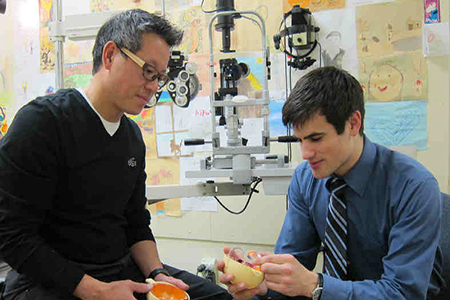The need for beauty in the world ensures that there is always a desire for the arts and a need for creative professionals. Young adults today combine art with a variety of disciplines including science urban development technology and the humanities. “By far the biggest trend we are seeing in art and design is the idea of collaboration across multiple disciplines,” says Terri Foote, director of virtual recruitment at Savannah College of Art and Design (SCAD). Students interested in art can either study the classical programs of painting drawing sculpture music and dance — or applied arts including fashion design industrial design graphic design animation and architectural design.
Traditional Fine Arts
Many art schools in the nation are built on the foundation of the classical arts: painting drawing sculpting music and dance performance. Even for contemporary programs a classical foundation is key. This is true even for some of the newer traditional fine arts disciplines. For example the character animation program at California Institute of the Arts (CalArts) still requires “observational drawing skills,” says Admissions Director Molly Ryan. But if you’re better at appreciating art than making it college programs also offer degrees in art criticism and art history. These are for students who want to evaluate and discuss art such as in preparation for a career as an art historian or gallery curator.
Specialized conservatory schools such as the New World School of the Arts (NWSA) provide classical training in the ancient forms of art. “Conservatory training is grounded in the fundamentals of the craft that will sustain a long and successful career,” New World School of the Arts Provost Jeffrey Hodgson says.
The New Angles of Design
Art students these days can be found in front of easels or computers on stages or even draping models. These artists engage in applied arts which use art to fulfill specific technical or functional purposes. This field is now connected with dynamic programs like animation motion graphics and video production. Sustainable design continues to grow but programs in fashion design stay strong as well. Kendall College of Design (MI) offers a degree in fashion studies for the first time this year. “There are exciting new opportunities in fashion right now,” says Kristopher Jones, an admissions officer.
Environmental and product design programs keep expanding too. Different types of industrial and product design continue to grow in popularity as young adults are working to make art that fulfills a purpose. Interior and product design using found or recycled objects is a hot area right now. For example designers are taking wooden pallets normally used for shipping and making them into bed frames gardening stands and bookshelves. Industrial designers collect repurposed materials and found objects and redesign them into new products like lamps furniture and kitchenware.
First Steps Toward an Art Degree
If a career in the arts fits you decide which type of school you’d like to attend in order to obtain your Bachelor of Fine Arts (BFA) degree. You can study at a specialized art school or within the art department of a traditional institution. Fine arts and design programs can also be highly competitive. Here’s what you need to know about applying.
Do your research. Check out school websites. Find out the programs and courses offered the ratio of liberal arts core courses to studio classes who the faculty members are and what connections the school has to museums galleries and design firms. Investigate work by current students and how the graduates of a school have fared in obtaining art-based jobs. Visiting a school will help you tell whether it’s an aesthetic environment you want to create in and whether you would likely fit with the type of people who attend there.
The Application and Portfolio
Colleges are looking for dedication and determination in their art and design applicants. After all art is a competitive field! Judith Aaron, vice president for enrollment at Pratt Institute says, “Most admissions officers in art and design schools . . . consider artistic skill very important as it not only shows what the student has learned but also indicates the extent of the student’s commitment” to his or her art. Seek out a teacher or mentor who will help you put together a collection of pieces for your portfolio. Somewhere between 10 and 20 pieces are usually required.
While drawing is an important skill to exhibit also include pieces in your portfolio that best reflect your talents interests versatility and commitment as an artist. One thing that most schools recommend is to participate in a National Portfolio Day event where you will have a chance to get your work reviewed by actual artists often from the schools you are applying to. You can find the schedule for National Portfolio Days at www.portfolioday.net.
But don’t neglect other components of your application either. Jones of Kendall says, “Admissions officers look for a balance of technical art skill and a passionate personality in creative thinking. Talent is a large part of it . . . but discipline is equally important.” Along with academic records and test scores schools like SCAD look at letters of reference purpose statements and a list of honors and awards. Aaron of Pratt notes that the academic record is important to show the student’s “work ethic and his or her ability to do well in the liberal arts.”
Outside the Classroom
Graphic design is now inextricably tied to Web design which involves an overlapping skill set. Carolina Wheat director of admissions at Parsons New School for Design points out that great artists “must have the ability to see differently interpret how they see and communicate with their own style hand-eye coordination and visual understanding in order to prove their unique sustainability in any art field.” In other words be creative and learn how to communicate in a lot of different ways whether verbally visually or through sound and motion.
Many schools also offer summer portfolio camps where high school students can build their portfolios work with fellow artists and receive critiques from college faculty. Foote of SCAD says, “Students attending a pre-college program should expect to push their artistic skills to the next level and leave with quality pieces to include in their portfolio.” Ryan of CalArts agrees: “Students who attend a pre-college program do tend to be better prepared for entering an art institution.” Foote suggests “Have a thirst for knowledge. Do not just rely on your high school teachers. Seek opportunities for study at local art centers art museums and with local artists.”
The possibilities in art are astounding. “Art majors end up doing a wide range of things like designing sneakers tableware cars or furniture creating graphic novels designing interiors of homes designing a fashion line creating films designing websites developing video games writing and illustrating children’s books . . . It depends on your interests,” says Aaron of Pratt. But Hodgson of NWSA emphasizes “The most important way to prepare is to tune out the mass-media drive to become famous or recognized and focus on the basics of your field of art.”
In other words don’t worry about whether your art will make you rich and famous. Just focus on what got you into the fine arts in the first place: enjoying the creative process!
Jill Hicks is the online editor of My College Guide.



